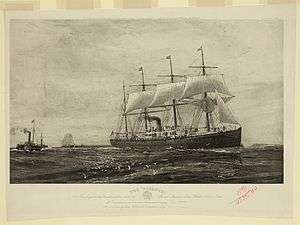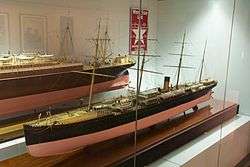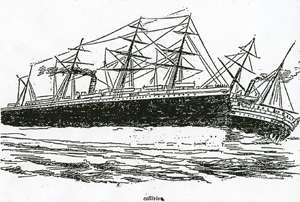RMS Oceanic (1870)
 The Oceanic off Queenstown on her second homeward voyage from New York, June 12th 1871, by William Lionel Wyllie, 1895 | |
| History | |
|---|---|
| Name: | RMS Oceanic |
| Owner: | White Star Line |
| Operator: | White Star Line (1871-1875); chartered to Occidental and Oriental Steamship Company (1875 - 1895) |
| Route: | |
| Builder: | Harland and Wolff, Belfast |
| Yard number: | 73 |
| Launched: | 27 August 1870 |
| Completed: | 24 February 1871 |
| Maiden voyage: | 2 March 1871 |
| Out of service: | 17 May 1895 |
| Fate: |
|
| General characteristics | |
| Class and type: | none |
| Type: | Ocean liner |
| Tonnage: | 3,707 gross tonnes |
| Displacement: | 7,940 tons (loaded) |
| Length: | 420 ft 4 in (128.12 m) |
| Beam: | 40 ft 10 in (12.45 m) |
| Depth: | 31 ft 5 in (9.58 m) |
| Installed power: | Four-cylinder compound steam reciprocating engine, comprising two high-pressure and two low-pressure cylinders, generating 1,990 ihp (1,480 kW) |
| Propulsion: | Propeller, sails |
| Sail plan: | Full-rigged ship |
| Speed: | 14.5 knots (26.9 km/h; 16.7 mph) (service speed) |
| Capacity: | 166 first class and 1,000 third class passengers |
| Crew: | 143 |
RMS Oceanic was the White Star Line's first liner and an important turning point in passenger liner design. Entering service in 1871 for Atlantic crossings, she was later chartered to Occidental and Oriental Steamship Company (O&O) in 1875. The ship provided passenger service for O&O in the Pacific until 1895 when she was sold for scrap.
Design and construction

Oceanic was built by Harland and Wolff in Belfast, and was launched on 27 August 1870, arriving in Liverpool for her maiden voyage on 26 February 1871. Powered by a combination of steam and sail, she had twelve boilers generating steam at 65 pounds-force per square inch (450 kPa), powered a single four cylinder compound steam engine, 2 x 78 inches (2.0 m) and 2 x 41 inches (1.0 m), with a stroke of 60 inches (1.5 m). A single funnel exhausted smoke and four masts carried sail. The hull was constructed of iron and divided into eleven watertight compartments. Passenger accommodations were located on the two decks concealed within the hull, as Oceanic could carry 166 First Class passengers, referred to as Saloon Passengers in those days and 1,000 Steerage Passengers, with a crew of 143. White Star had spared no expense in her construction, and the contemporary press described the ship as an "imperial yacht".
Innovative features included positioning the first class passenger cabins amidships, away from the vibration of engines and with the least ocean movement. Third class passengers were placed at the bow and stern of the ship. All first class passengers could be seated at once in the first class dining saloon amidships. Portholes in the ship were much larger than on contemporary liners, providing more light. Running water was available in most if not all the first class cabins. There were also electric bells to summon a steward. As for the steerage accommodations, the White Star Line used Oceanic to create a trademark for themselves in reference to the treatment of steerage passengers. The White Star Line was among only a handful of Trans-Atlantic Passenger lines to segregate their steerage accommodations into two sections; berthing for Single Men was located in the Bow, while berthing for Single Women, Married Couples and Families was in the Stern.
Service history

Oceanic left for her maiden voyage from Liverpool on 2 March 1871 carrying only 64 passengers, under Captain Sir Digby Murray. Not long after departing, she had to return because of overheated bearings. Her voyage restarted on 16 March. From that point onward, Oceanic was a success for The White Star Line.
Three sister ships were constructed in rapid succession: Atlantic, Baltic, and Republic. All were of the same approximate dimensions with differences in tonnage.
In January, 1872, Oceanic underwent a refit, during which a large forecastle was added to help prevent the bow being inundated during high seas. Two new boilers were added to increase steam pressure and thus engine power, and the four masts were shortened.
Oceanic continued sailing with the White Star line on the Liverpool to New York City route until 11 March 1875, when she was chartered to the Occidental & Oriental Steamship Company, for service between San Francisco, Yokohama and Hong Kong. White Star provided the officers, while the crew was Chinese. The ship itself remained in White Star colours, but flew the O&O flag. During the repositioning voyage from Liverpool to Hong Kong, Oceanic set a speed record for that route. Later, she also set a speed record for Yokohama to San Francisco in December 1876, and then broke her own record over that route in November, 1889, with a time of 13 days, 14 hours and 5 minutes.
On 22 August 1888, Oceanic collided with the coastal liner SS City of Chester just outside the Golden Gate; the latter ship sank, killing 16 on board.[1]
On 7 January 1890, Nellie Bly boarded Oceanic in Yokohama to cross the Pacific as part of her voyage Around the World in Seventy-Two Days. She arrived in San Francisco on 21 January 1890, which was a day behind schedule as a result of rough weather.
In 1895, Oceanic was returned to White Star, which planned on putting her back into service. She was sent back to Harland and Wolff for re-engining, but when the ship was inspected closely, it was found to be uneconomical to perform all the work needed. Instead, she was sold for scrap, leaving Belfast for the last time on 10 February 1896, under tow, for a scrapyard on the River Thames.
References
- ↑ The New-York Times, 23 August 1888
External links
| Wikimedia Commons has media related to Oceanic (ship, 1870). |
- Oceanic info at The Great Ocean Liners
- For a listing of passengers on one voyage
- Video dedicated to RMS Oceanic 1899